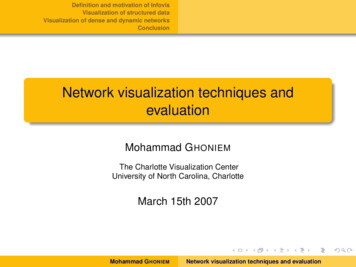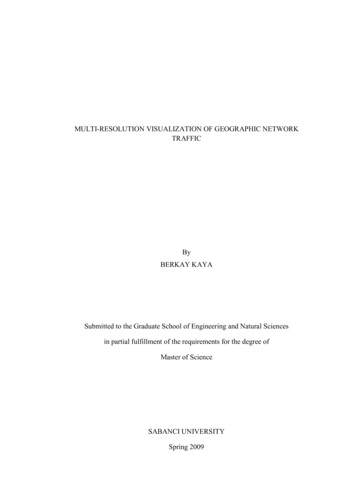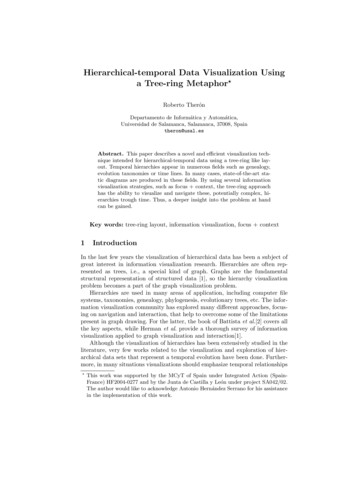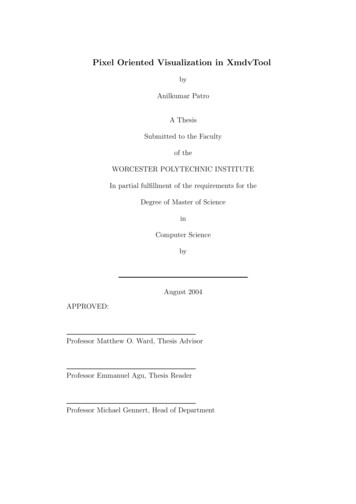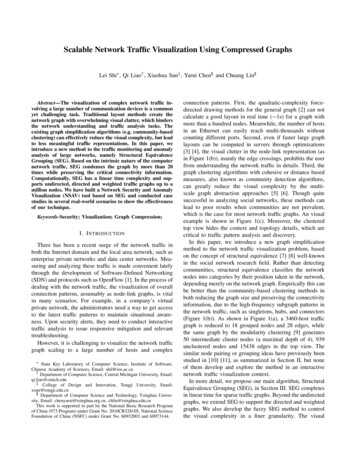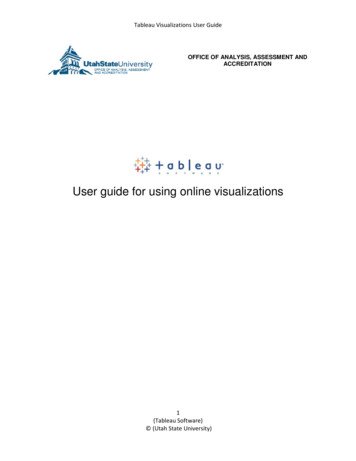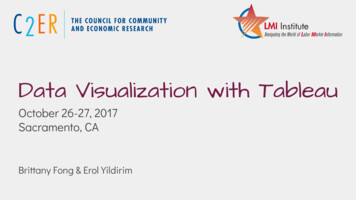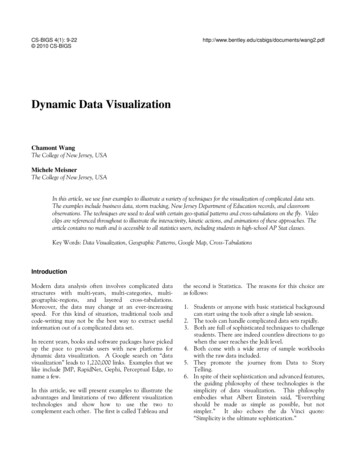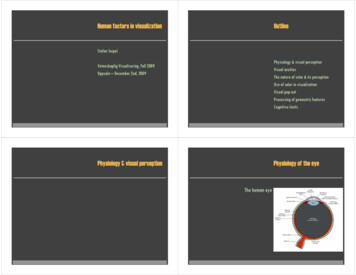
Transcription
Human factors in visualizationOutlineStefan SeipelPhysiology & visual perceptionVisual acuitiesThe nature of color & its perceptionUse of color in visualizationVisual pop-outProcessing of geometric featuresCognitive limitsVetenskaplig Visualisering, Fall 2009Uppsala – December 2nd, 2009Physiology & visual perceptionPhysiology of the eyeThe human eye
Physiology of the eyeReceptors of two types : cones and rodsRetinaRods (”stavar”):Sensitive at low light levelApproximately 100 millionContribute little at daylight (overloaded at daylight levels)Are interconnected over larger areasPhysiology of the eyeReceptor arrangementBlind spotAt approx. 15 degrees lateralExperiment: Two thumbs- follow instructionsCones (”tappar”):Effective at daylight levelsColor sensitive (more details later)Are highly packet at the fovea (180 per degree visual angle)Approx. 100.000 at the foveaApproximately 6 million in totalFovea1,5-2 degrees of visual angleCorresponds to an area size s 2,5 cm at d 70 cmImages: mPhysiology of the eyeReceptor arrangementRetinaRetinaPhysiology of the eyeReceptor arrangement(compare figure 2.15 in C. Ware)Blind spotBlind spotAt approx. 15 degrees lateralExperiment: Two thumbs- follow instructionsAt approx. 15 degrees lateralExperiment: Two thumbs- follow instructionsFoveaFovea1,5-2 degrees of visual angleCorresponds to an area size s 2,5 cm at d 70 cm1,5-2 degrees of visual angleCorresponds to an area size s 2,5 cm at d 70 cmImages: mRetina1,5-2 degrees visual angle
Visual AngleVisual angle to define:Definition:Focal field of view defined 1 degrees visual angleVisual angle is the angle subtended by anobject at some distance to the observer.Size of a thumbnail at approximately arms length1 cm at 57 cm distanceSensor “granularity” is 20 arc sec. visual angle- 0.05 mm at 57 cmVisual acuitiesWhen describing visual acuities and properties,visual angle is used because it is independentof viewing distances and objects viewed. α s 2 d tan 2 Visual AcuitiesPoint acuity: 1 minute of arcVisual AcuitiesPoint acuity: 1 minute of arcGrating acuity: 1-2 minutes of arc
Visual AcuitiesPoint acuity: 1 minute of arcGrating acuity: 1-2 minutes of arcLetter acuity: 5 minutes of arc (5,8 mm at 4 meters distance)Visual AcuitiesPoint acuity: 1 minute of arcGrating acuity: 1-2 minutes of arcLetter acuity: 5 minutes of arc (5,8 mm at 4 meters distance)Vernier acuity: 10 seconds of arcEFPTOZLPEDPECFDEDFCZPVisual Acuities Acuity depends on brightness/contrastTempleBlind spot Several receptors interconnected - superacuity50Fovea Acuity fall-off across visual field: Compare figureLimited point and line acuity100Relative acuity (% of maximum)Point acuity: 1 minute of arcGrating acuity: 1-2 minutes of arcLetter acuity: 5 minutes of arc (5,8 mm at 4 meters distance)Vernier acuity: 10 seconds of arcVisual Acuities and ColorNose050Distance from fovea (in degrees visual angle)30100103050Spatial color blending
Visual Acuities and ColorVernier acuityVisual acuities depend on colorand illuminationVisual Acuities and ColorLetter acuityEEEFPFPFPTOZNature of color & perceptionVisual acuities depend on colorand CZPEDFCZPWhat is color?Is color a property of light?Is color a material property?Is color a visual experience? all of it is the case
Interaction between light hittinga surface with some material property.A surface that reflects only the shortwavelength components of incidentdiffuse light.Specular reflection of all otherSpectral components.The nature of colorThe nature of colorLight – visible part of theElectromagnetic spectrumLight sources: Color defined as a spectral denisty Luminescent colorsThe nature of colorThe nature of colorColor - a material propertyColor as a visual experienceWhen irradiant light is hitting surfaces, parts ofthe spectra are absorbed.The spectral density of the reflected lightcharacterizes the color of the surface. It dependson the material properties of the surface.Emitters of electromagnetic radiation in thevisible part of the EM spectrum.Luminescent or reflected light of some color issensed on the retina (low level processing)perceived as a stimulusphotoreceptorsganglion cells, center surround cells Reflection colorsinterpreted (high level processing)visual cortex
Color perceptionTri-stimulus model of color perceptionColor perception1,2555 nm1Three types of cones (S, M, L)Red peak:Green peak:Blue: Green 555 nm, peak Blue 450 nm, 4% of max sensitivity0,8564 nm533 nm437 nm0,60,40,2RodsGreen (dark):498 nmRelative sensitivity of the eye Blue is not a good choice in presence of green or red0Qualitative spectral response curves for photoreceptorsRelative sensitivity to different wavelength according to CIE (V(l) (Values from Ware 2005)Color perceptionChromatic aberrationRelative sensitivity of the eyeFocus-feedback loop triggeredby M- and L-receptor stimuli Green 555 nm, peak Blue 450 nm, 4% of max sensitivity Blue is out of focus Appears at different depthCan you read this?Can you read this?Can you read this? Blue is not a good choice in presence of green or redRefraction of light depends on optical power of the lens wavelength of the light
Chromatic aberrationMost people see the redcloser than the blueBut some see theopposite effectFocus-feedback loop triggeredby M- and L-receptor stimuli Blue is out of focus Appears at different depthLuminance, lightness and brightnessDefinitions:Luminance is the measurable amount of light coming from some region in space.It is a physical property that can be exactly measured (eg. Candela per square meter).Brightness is the perceived amount of light coming from self-luminous objects.Lightness refers to the perceived reflectance of a surface. A white surface is light a black one is dark.Chromostereopsis: Text appears at different depths due to chroma60% see red to appear closer30% see blue to appear closer10% don’t see a differencePerception of brightness levelsCompare the lightness of the marked fields!Perception of brightness levelsColor and shades not useful to encode and visually decode absolute value
Perception of brightness levelsHuman visual system is not an absolute measuring devicePerceived lightness/brightness depends on : Overall ambient light level adjustment (photo pigment bleaching) The illuminant and spatial illumination conditions (see illusion next slide) Colors in the surround of an object (see illusion picture) Local contrast effectsAmbient light levels: 50.000 Lux (sunlight) 50 Lux (interior artificial illum.) 0.5 Lux (moonlight)Interpretation of chromaAgain, the human visual system is not an absolute measuring device.Color perception also depends on a number of factors: Overall ambient light level adjustment (photo pigment bleaching) Colors in the surround of an object Local contrast effectsExample: A black object on a sunny day outside reflects more light than a white object inside anoffice room. Still, we perceive the black object as dark and the white one as light.The color of the crossesThe color of the crosses
Pigment bleachingChromatic AdaptationWhat color is the shirt of the lady not raising her hands?Afterimages of complementary colorsChromatic AdaptationDid you sayyellow ? Ah, right!Chromatic AdaptationThis is the original picture without a color filter.You are right. The color is yellow!
Chromatic AdaptationChromatic AdaptationLet s copy the top of the lady from picture 1 into picture 2!Here is the direct comparisonIn fact, the color of the shirt was not yellow!Lessons learned:Color can not only be defined by physicalquantitiesColor perception is biased by situationalconditionsImpression of color is subjectiveContrast processingVisual perception is not directly based on singularneural signals of receptors in the retina.Instead, there is some neural processing inseveral layers of retinal ganglion cells. Circular receptive fieldsContrast processingGanglion cells are organized with circularreceptive fields that can have an on-centeror off-center.Size of receptive fields varies from centralfield of view to periphery.Circular receptive fields generate responsefor differentialsLateral inhibition/sensory inhibition (Hartline 1949)
Contrast processingBehavior of the differential responsecan be modeled using two Gaussiancurves.Difference of Gaussian (DoG) modelcan explain a number of contrastphenomena.Simultaneous contrastDOG model explains simultaneous contrastGray boxes in front of color ramp appear inshifting tones (top picture)All boxes in a line have same luminanceDoG response of actual intensity profile iscongruent with perceived effect (bottom picture)Mach band effectExperiment blue colors
Hermann GridContrast and visual stressUnder certain visual conditions: Spatial frequency of 3 deg./ visual angle High contrast Circular/periodic patternsUse of color in visualization
Perceptual limitsA practical experiment : Part 1Temporal limits – change blindnessPerceptual limitsA practical experiment : Part 1Common colorsEthnographic studiesCross-cultural consistency of primary color termsTwo most frequent words for colors: Black and WhiteThird color: RedFourth and fifth color: Green and Yellow (or vice versa)Sixth color: BlueSeventh color: BrownEigths color: Pink or purple, orange, grayFirst six colors correspond to color axes in opponentcolor theoryUnique naming of colors - useful for codingTemporal limits – change blindnessUnique huesWe distinguish 10 million different colorsUnique naming only for 8 colors out of a selectionof 210 colors (with 75% confidence)Very high between subject confident forunique yellow (within 2 nm)Colors that are not basic (lime green, orange )- are not easy to remember- are not named the same with confidence- avoid to use as code for categories
Use of color – Reading textAnother reading exampleYour browser's default home page appears toSupporting readability(Perceptual level)have been changed from your original choice.Use of color – ReadingWhen colors are used as labels:Supporting semantics(Cognitive level) Learned meanings and conventionsEither your Symantec application has removed a Consider “Intuitive” usethreat that changed your home page, or youhave chosen Symantec Home Page Assistanceafter installing a Norton program. As part of therepair process, read below on how to return yourdefault home page to your preferred setting.Name the colors of the words! Avoid interaction with other textualor symbolic meaningName the colors of the BlueOrangeGrayRedGreen
Use of color – LabelCriteria : Distinct colors (rapid recognition) Unique hues (avoid misinterpretation) Contrast with background Limit the number (5-10) Field size Not too small - visual acuities Large areas - low saturationEncoding nominal data-Must be recognizedNo requirement for orderingUse of color – LabelLondon tube mapVisual Pop-out
Color calls attentionVisual Pop-outDefinition of visual pop-outSaturated colors on achromaticbackground/context are processed pre-attentively.Visual pop-out occurs when visual features areprocessed pre-attentively. I.e. in a visual task,involving identification of visual targets, time neededfor identification is not depending on the number of thedistractors (non-target elements).Identification of colored features in this contextrequires no cognitive processing.Pre attentive features useful for rapid searchtasks!Chrominance differences are useful as visual pop-out.Ready for a test?cETqkTL7BjrkbUZSX2hyG8X6ökVisual Pop-outVisual Pop-outExample: Count the digits!ExamplerzE L GA 3 PwT r 5ct PGq UkfXi W y hY g k Z rDydAL k LZ 7 U i Mu8R jS d jkKö EBL
cETTyLS7BjrzE L GA 3 Pwr 5Tct PGq UkfXi W y hY g k Z ryd D LAk LZ 7 U i M8uR jS d jkKö EBLbX6öExamplerkUZExampleX2hVisual Pop-outG8qkVisual Pop-outkGeometric featuresGeometric featuresAssessment of lengths and anglesAssessment of lengths and anglesEstimate the angles between the two lines!Estimate the angles between the two lines!Estimate absolute lengths of the two lines!Estimate absolute lengths of the two lines!Which line is longer?Which line is longer?
Geometric featuresSpatial layout in 3DTime-geography:Ambiguity problem:Static 2D presentations of 3D graphical expressionscannot be evaluated correctly!Re-evaluate what can be seen in3D time-space graphsWhich face is in front?Ambiguities can be resolved throughMotion parallaxa) Shape from motionb) Dynamic observerTorsten HägerstrandWhat object does this represent?(1916 – 2004)Binocular cuesProfessor of GeographyGognitive limitsExperiment 1:Count the passes of the black team!Gognitive limitsInattentional blindnessWe see what we want to see and miss otherobvious things!
Gognitive limitsExperiment 2Visualization
Gognitive limitsChange blindnessDue to limited short-term memory we can notremember/identify changes in visual scene reliablyif there is some disruption is introduced.
Human factors in visualization Stefan Seipel Vetenskaplig Visualisering, Fall 2009 Uppsala – December 2nd, 2009 Outline Physiology & visual perception
